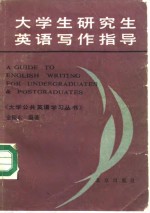

大学生研究生英语写作指导PDF电子书下载
- 电子书积分:12 积分如何计算积分?
- 作 者:金振东编著
- 出 版 社:北京:北京出版社
- 出版年份:1990
- ISBN:7200008958
- 页数:305 页
PART ONE THE WORD 1
Ⅰ.Appropriateness and Exactness 1
A..Appropriateness 1
1.Standard and nonstandard English 1
2.Usage Labels 2
3.Formal,Informal,and General Written English 3
4.Four Types of Words 6
B.Exactness 8
1.Spedificity 8
2.Denotation and Connotation 10
3.Euphemisms 12
4.Triteness 12
Ⅱ.Vocabulary 14
PART TWO THE SENTENCE 17
ⅠUnity 17
A.Fragments 17
B.Pronoun Reference 18
Ⅱ.Coherence 20
A. Subject-Verb Agreement 20
B.Pronoun Refernce 22
C.Parallelism 23
D.Misplaced and Dangling Modifiera 25
1.Misplaced Modifiera 25
2.Dangling Modifiera 26
2.Incomplete Contruction 28
1.Mixed Contruction 28
E.Mixed and Incomplete Contruction 28
F.Incompatible Tenses 30
G.Abrupt and Confusing Shifts in Point of View 30
1.Shift form Past to Present Tense 30
2.Shift form Active to Present Tense 31
3.Shift form Singular to Plural 31
4.Shift form Onr Mood to Another 31
5.Shift form Statement to Question 31
Ⅲ.Emphasis 31
A.Pcsition 32
B.Emphatic Word,Phrases,and Structures 33
D.Repetition 35
C.Order od Climax 35
E.Subordination 36
Ⅳ.Conciseness 36
A.Extra Word and Empty Words 37
B.Weak Intendifiers and Quslifiers 38
C.Circumlocutions 38
D.Redundancy 39
Ⅴ.Variety 39
A.Lengtb 40
B.Grammatical Structures 40
1.Three Kinds of Rhetorically Considered Sentences-Loos,Peridic,and Baland Sentences 40
2.Active and Passive Voices 42
Ⅰ.Topic Sentence and Controlling Iden 45
PART THREE THE PARAGRAPH 45
Ⅱ.Unity 47
Ⅲ.Methods of Development 50
A.Chronological Description 50
B.Cause-and-Effect Analysls 52
C.Pross Analysis 54
D.Comparison and Contrast 55
E.Listing 56
F.General-to-Specific Order 58
G.Specific-to-Grneral Order 60
H.Definition 62
I.Classification 64
J.Order of Climax 65
Ⅳ.Coherence 66
A.Three Essential Elements of Patagraph Coherence Order,Trandition,and Sentence Combining 66
B.Transitional Devices 70
1.Transitional Word and Phtases 71
2.Repitition of Key Word and Phrases 74
PART FOUR THE ESSAY 76
Ⅰ.The General Structure 76
A.The Inteoduction 76
B.The Body Paragraph 77
C.The Conclusion 78
Ⅱ.From Paragraph to Essay 79
B.Choosing Your Subject 84
A.Dfining Youer Purpose 84
C.Identifying Your Audience 86
D.Forming a Rhesis Statement 87
E.Outlining 89
1.The Format of the Ourline 89
2.The Topic Outline and the Sentence Outline 89
Ⅳ.Types of Writing 97
A.Narration 97
1.Narrative Detail 98
2.Narrative Variety 98
3.Narrative Order 99
5.Sample Narrative Essays 100
4.Structuring a Narrative Essay 100
B.Description 108
1.Objective and subjective Desceittions 109
2.Objective and subjective Language 112
3.Selection of Detail 113
4.Structuring a Descriptive Essay 114
5.Sample Descriptive Essays 115
C.Argumentation 124
1.Choosing a Topic 125
2.Taking a Stand 126
3.Gatthering Your nAudience 127
4.Analyzing Your Audience 127
5.Deduction and Induction Argument 128
6.Fallacies of Argument 132
7.Structuring an Argumentative Essay 134
8.Sample Argumenttative Essays 135
D.Expisition 145
1.Developing a Topic 145
sample Expository Essay1 146
2.Explaining aProcess 148
sample Expository Essay2 148
3.Description in Exposition 150
sample Expository Essay3 151
4.Narration in Exposition 152
sample Expository Essay4 153
PART FIVE THE RESEARCH ESSAY 157
Ⅰ.The Research Procedure 157
A.Choosing a Subject 159
Ⅱ.The Investigative Process 159
B.Reading 160
C.Preparing a Bibliography 161
1.The Working Bibliography 162
2.The Form of the Working Bibliography 163
3.The Final Bibliography 169
D.Taking Notes 170
1.The Form of Notes 171
2.Suggestions fpr Note-taking 172
3.The Summarizing Note 174
Ⅲ.Writing the Paper 176
B.The Rule for Placing Footnote Numbers within the Text 179
A.Two Kinds of Footnotes 179
Ⅳ.Footnoting 179
C.The Article Footnote 180
D.The Article Footnite 181
E.Differences Between Footnote and Bibliography Forms in the Humanities 182
F.Abbreviations in Footnotes 183
G.Format 185
1.The Title Page 185
2.The Outline 186
3.The Body of the Research Paper 186
4.Chapters 186
5.Conclusion 186
6.Footnote Numerals 186
9.Italics 187
10.Margins 187
7.Footnotes 187
8.Introduction 187
Ⅴ.Two Sample Research Paper 188
PART SIX THE LETTER AND THE RESUME 213
Ⅰ.The Letter 213
A.General Information 213
1.The Heading 213
2.The Margin 215
3.The Salutation 215
4.The Body 215
5.The Complimentary Close 215
8.The Envelope 216
6.The Signature 216
7.The Postscript 216
B.The Personal Letter 217
1.The Salutaion 217
2.The body 217
3.The Complientary Ciose 219
4.The Signature 219
5.Sample Personal Letters 219
C.The Business Letter 221
1.The Heading 221
2.The Salutation 222
3.The Bodt 222
6.Sample Business Letters 224
4.The Complimentary Close 224
5.The Signature 224
Ⅱ.The Resume 227
A.Heading 227
B.Statement of Personal Goals 227
C.Information about Schooling 227
D.Details of Work Experirnce 228
E.A Sanple Resume 228
PART SENEV THE TECHNICAL REPORT 230
ⅠWriting Informal Reports 230
A.Informal Report on a Meeting 231
B.Informal Report on a Laboratory Investigation 235
C.Informal Report on the Progress of an Investigation 250
Ⅱ.Writing Formal Reports 252
A.Reasons for Making a Formal Presentation 253
B.Typical Repory Contents 253
1.Prefatory Pages 254
2.Introductory Summary 257
3.Report Proper 258
4.Aooendixes 263
C.A Sample Formal Report 263
PART EIGHT PUNCTUATION 285
Apostrophe(') 285
Asterisk(*) 287
Colon(:) 288
Brackets([ ]) 288
Comma(,) 289
Dash(—) 296
Ellipsis(…) 297
Exclamation Point(!) 297
Hyphen(-) 297
Period (Full Stop)(.) 299
Question Mark(?) 300
QuotationMatks(" "and' ') 300
Semicolon(;) 301
Slash(/) 302
Underlining(Italics) 302
BIBLIIGRAPHY 304
- 《女丹仙道:道教女子内丹养生修炼秘籍 下》董沛文著 2012
- 《高考快速作文指导》张吉武,鲍志伸主编 2002
- 《红色旅游的社会效应研究》吴春焕著 2019
- 《大学计算机实验指导及习题解答》曹成志,宋长龙 2019
- 《汉语词汇知识与习得研究》邢红兵主编 2019
- 《生物质甘油共气化制氢基础研究》赵丽霞 2019
- 《东北民歌文化研究及艺术探析》(中国)杨清波 2019
- 《联吡啶基钌光敏染料的结构与性能的理论研究》李明霞 2019
- 《激光加工实训技能指导理实一体化教程 下》王秀军,徐永红主编;刘波,刘克生副主编 2017
- 《异质性条件下技术创新最优市场结构研究 以中国高技术产业为例》千慧雄 2019
- 《市政工程基础》杨岚编著 2009
- 《家畜百宝 猪、牛、羊、鸡的综合利用》山西省商业厅组织技术处编著 1959
- 《《道德经》200句》崇贤书院编著 2018
- 《高级英语阅读与听说教程》刘秀梅编著 2019
- 《计算机网络与通信基础》谢雨飞,田启川编著 2019
- 《看图自学吉他弹唱教程》陈飞编著 2019
- 《法语词汇认知联想记忆法》刘莲编著 2020
- 《培智学校义务教育实验教科书教师教学用书 生活适应 二年级 上》人民教育出版社,课程教材研究所,特殊教育课程教材研究中心编著 2019
- 《国家社科基金项目申报规范 技巧与案例 第3版 2020》文传浩,夏宇编著 2019
- 《流体力学》张扬军,彭杰,诸葛伟林编著 2019
- 《指向核心素养 北京十一学校名师教学设计 英语 七年级 上 配人教版》周志英总主编 2019
- 《北京生态环境保护》《北京环境保护丛书》编委会编著 2018
- 《指向核心素养 北京十一学校名师教学设计 英语 九年级 上 配人教版》周志英总主编 2019
- 《高等院校旅游专业系列教材 旅游企业岗位培训系列教材 新编北京导游英语》杨昆,鄢莉,谭明华 2019
- 《指向核心素养 北京十一学校名师教学设计 数学 九年级 上 配人教版》周志英总主编 2019
- 《西单大杂院-北京老舍文学院首届中青年作家高研班学员小说作品集》北京老舍文学院编 2019
- 《指向核心素养 北京十一学校名师教学设计 数学 七年级 上 配人教版》周志英总主编 2019
- 《北京人民艺术剧院剧本系列 白露》刘国华,马鹏程 2019
- 《北京模式》吴建繁,王德海,朱岩编 2017
- 《指向核心素养 北京十一学校名师教学设计 数学 八年级 上 配人教版》周志英总主编 2019
